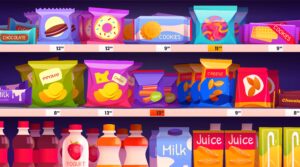Unpacking the Truth: The Impact of Packaged Foods on Your Health
Packaged foods—also referred to as processed or convenience foods—have ingrained themselves deeply into our everyday routines. These include prepared meals, snacks, and drinks; they also include frozen and canned goods, as well as certain “health foods” like protein shakes and energy bars. However, the ease of packaged foods comes at a cost, and it’s important to unpacking the truth about their impact of packaged foods on your health, includes increased risk of obesity, type 2 diabetes, heart disease.
The common thread across all of these processed foods is that they have undergone various processing stages, which can involve cooking, baking, drying, freezing, canning, and adding preservatives, flavor enhancers, and other ingredients. In this discussion, we will unpacking the truth about the impact of packaged foods on your health, looking at the nutritional, environmental, and social aspects of these ubiquitous products.
The Nutritional Challenge:
One of the key concerns about packaged foods is their influence on our nutritional health. Research published in 2023 explains that packaged foods are high in added sugars, salt, unhealthy fats, and are deficient in important nutrients, which may results in obesity, dental decay, delayed development, food poisoning, and other health issues. Understanding the nutritional value of these items is essential for making informed dietary decisions.
- High in Added Sugars: Most packaged foods, particularly snacks and sweetened beverages, are high in added sugars. In addition to providing empty calories, these additional sugars raise the risk of obesity, type 2 diabetes, and heart disease. Too much sugar intake can also result in dental problems including tooth decay. Hidden sugars can be identified by reading nutrition labels because they go by many different names, like sucrose, agave nectar, and high fructose corn syrup.
- Excessive Salt (Sodium): Packaged goods are known for their high salt content, which is frequently used to enhance flavor and increase shelf life. Excessive salt consumption can cause blood pressure to rise as well as an increased risk of heart disease, stroke, and renal issues. Reducing salt consumption by selecting low-sodium options and cooking fresh dishes at home can help lessen these hazards.
- Unhealthy Fats: Packaged foods, such as baked goods and some margarine, may include trans and saturated fats. Avoiding these unhealthy fats is recommended because they may lead to the development of cardiovascular problems. Trans fats in packaged foods can be identified by looking for partially hydrogenated oils in the ingredient lists.
- Lack of vital Nutrients: Packaged foods frequently lack vital nutrients such as vitamins, minerals, and fibre. The majority of processed foods are “empty calories,” meaning they add calories to the diet but have little nutritious benefit.
- Artificial Additives: Packaged foods frequently contain flavor enhancers, preservatives, artificial colors, and other additives. While regulatory authorities generally consider these additives to be harmless, some individuals may be allergic or sensitive to them. Selecting foods with little to no processing will help lower your exposure to these additives.
It is crucial to emphasize that not all packaged goods are unhealthy and that some can be beneficial for a balanced diet when consumed in moderation. However, because of their nutritional composition, a considerable fraction of processed foods can pose health hazards. The secret is to use them moderately in addition to fresh, whole meals, and to be aware of their nutritional value.
Why is the Food Labelling important?
It is essential to understand the nutritional content of packaged foods in order to make informed decisions. Food labelling contains vital information that can assist consumers in determining the healthfulness of a product. Here are some important points about food labelling to think about:
- Nutrition Facts Panel: This panel offers information on serving size, calories, and macronutrient quantities (such as fat, carbs, and protein), as well as particular nutrients such as vitamins and minerals. Additionally, it has information on daily values, which can assist you in determining the nutrient content of a product.
- Ingredient List: The ingredient list exposes what is in the product and lists the ingredients in descending order by weight. Extended ingredient lists that contain unfamiliar or difficult-to-pronounce words should be avoided since they can suggest a highly processed product.
- Claims and Labels: Be careful of labels that use terms like “organic,” “low fat,” or “reduced sodium.” These claims might assist you in identifying products that are compatible with your dietary objectives. To obtain the whole picture, be critical and refer to the ingredient list and Nutrition Facts panel.
- Serving Size: The serving size stated on the Nutrition Facts label can be misleading. Consider if your average portion size matches the serving size indicated, as this can have a considerable impact on the nutritional composition of what you consume.
- Percent Daily Value (%DV): The %DV on the Nutrition Facts panel represents the percentage of a nutrient in a serving of food that contributes to a daily diet. It is based on a daily calorie intake of 2,000, which may not be appropriate for your specific needs. Use this as a broad guideline, but keep your individual needs in mind.
Also read|11 Reasons Why sugar is called White Poison
What are Environmental Impacts of packaged foods?
Packaged foods have an influence on the environment in addition to our health. The production, packaging, and shipping of these products can have substantial environmental repercussions, which is a growing issue as we face the problems of climate change and sustainable living.

- Packaging Waste: The excessive amount of packaging is the most evident environmental problem related to packaged foods. According to study published in 2020, Plastics used in food packaging constitute the majority of waste plastic that contaminates the environment. Waste from the boxes, wrappers, and containers that hold these products is considerable. This waste frequently finds its way into landfills and contaminates our streams and oceans with plastic debris.
- Energy Consumption: The processing, transportation, and refrigeration of packaged foods all need substantial quantities of energy. This energy consumption contributes to greenhouse gas emissions and worsens climate change.
- Land Use and Agriculture: The production of ingredients utilized in packaged foods can potentially have negative environmental consequences. The production of essential ingredients like palm oil and soy, which are utilized in many processed foods, is frequently linked to large-scale monoculture farming, the use of pesticides, and deforestation.
- Water Use: Water shortages in some areas might result from the food industry’s heavy water consumption. Food processing and ingredient cultivation can put a strain on local water resources.
- Food Miles: Packaged goods can travel vast distances from manufacturing facilities to store shelves, adding to a considerable carbon footprint owing to transportation emissions.
A few strategies to lessen the negative effects of packaged food on the environment are the use of biodegradable packaging materials, recycling programmes, and purchasing ingredients from ethical and sustainable sources.
What are Social Implications of packaged foods?
Packaged foods also have social impacts that go beyond people’s health and the environment. These consequences include concerns such as economic disparities, availability of nutritional food, and cultural impacts on dietary choices.]
- Economic Disparities: Processed foods are frequently less expensive and more accessible than fresh, wholesome foods. Since lower-income people and families may have to rely more on packaged foods due to financial constraints, this could result in disparities in the quality of diets. Consequently, they can be more susceptible to health issues linked to diet.
- Food Deserts: Places with limited access to fresh, healthful food options exist, especially in low-income neighbourhoods. This phenomenon is referred to as a “food desert, ” where individuals must rely on convenience shops and fast food outlets for their daily needs due to the lack of grocery shops and fresh food markets.
- Cultural Influences: Packaged foods may sometimes overshadow traditional and culturally relevant food choices. The globalization of the food industry and the prevalence of convenience food may result in the destruction of traditional culinary practices, affecting cultural identity and community cohesion.
- Food marketing: The promotion and marketing of packaged foods, particularly those meant for children, can affect dietary preferences and encourage the ingestion of unhealthy options. Marketing strategies frequently highlight the appeal of flavor and convenience, sometimes at the price of nutritious value.
- Health Inequities: Consuming processed foods is associated with health inequalities because those who have less access to wholesome, fresh food are more likely to experience diet-related health issues. This leads to healthcare and health outcomes inequities.
What are some alternatives to packaged foods?
While the influence of packaged foods on our health, the environment, and society raises valid concerns, it is crucial to recognize that not all packaged foods are intrinsically bad. There are alternatives that can be convenient without compromising sustainability or nutrition.
- Reading Labels: Reading the nutrition labels on packaged foods is one of the best methods to make informed decisions. Search for products with a lower level of unhealthy fats, added sugar, and salt. Keep an eye on the ingredient list to avoid products containing artificial additives and preservatives.
- Prioritizing Whole Foods: Whole, unprocessed foods like fruits, vegetables, whole grains, and lean proteins should always come first. These alternatives are often more nutritious and have a lower environmental impact.
- Cooking at Home: Cooking food at home gives you more control over what ingredients you use and may help you stay away from unhealthy additives. Cooking may be a rewarding and joyful experience as it allows you to adapt your meals to your preferences and nutritional requirements.
- Supporting Local and Sustainable Brands: When selecting packaged foods, take into consideration companies that prioritize ethical production methods, minimal processing, and sustainable sourcing. Supporting local and eco-friendly brands will help you lessen the environmental effect of your food choices.
- Reducing Packaging Waste: Choose products with the least amount of packaging possible, or buy in bulk and use reusable containers to decrease waste. Reducing waste can also be accomplished by supporting sustainable packaging practices and taking part in recycling programmes.
- Advocating for Change: As customers, we have the potential to modify the food industry and encourage more sustainable, healthier practices. We can bring about positive change in our communities by pushing for better food options, demanding transparency, and supporting projects that decrease food waste.
Conclusion:
The impact of packaged foods on society, the environment, and health is a complicated issue. Convenience has its advantages, but it also has severe environmental consequences. Reducing our carbon footprint and improving human health are both made possible by understanding the nutritional makeup of packaged foods. Addressing societal concerns such as economic disparities and accessibility to nutritious foods is also important. A more equitable food system is required to ensure that everyone has access to good, inexpensive food. We can encourage a healthier, more sustainable food environment in the future by striking a balance between convenience and health.

